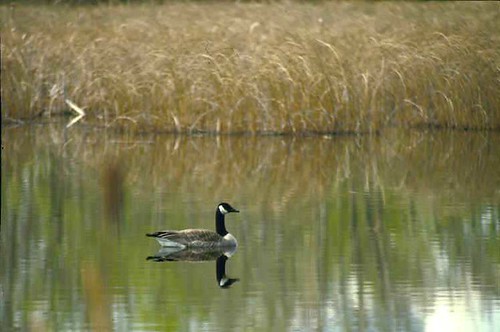
Canada Goose, Branta canadensis, with reflection.
Click image for larger view in another window.
Photo: TFlockhart.
Avian Mysteries
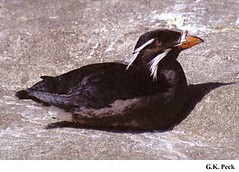 Hundreds of the seabirds known as rhinoceros auklets, Cerorhinca monocerata (pictured, left), have died and are washing up on the southern Oregon coast, but scientists haven't settled on an explanation for their deaths. Beach observers say that hundreds of carcasses -- as many as 20 to 30 per mile -- were reported last week. Explanations include a storm that killed lots of birds as they were gathering for breeding season and warming ocean waters that are inhospitable to the bird's food chain (there is research that supports this second hypothesis). "The questions in my mind are: Is this something that's widespread in Oregon? Is it a freak event like a storm, or something that's going to last longer?" said seabird researcher Julia Parrish, an associate professor of biology at the University of Washington.
Hundreds of the seabirds known as rhinoceros auklets, Cerorhinca monocerata (pictured, left), have died and are washing up on the southern Oregon coast, but scientists haven't settled on an explanation for their deaths. Beach observers say that hundreds of carcasses -- as many as 20 to 30 per mile -- were reported last week. Explanations include a storm that killed lots of birds as they were gathering for breeding season and warming ocean waters that are inhospitable to the bird's food chain (there is research that supports this second hypothesis). "The questions in my mind are: Is this something that's widespread in Oregon? Is it a freak event like a storm, or something that's going to last longer?" said seabird researcher Julia Parrish, an associate professor of biology at the University of Washington.
People Helping Birds
Duck and goose hunters have a great opportunity to let the U.S. Fish and Wildlife Service (USFWS) know what they think about migratory bird management in the United States. During the next 34 days, USFWS will hold 12 public meetings around the country to hear what you have to say. It's all part of a process that will result in drafting a Supplemental Environmental Impact Statement (SEIS) on the hunting of migratory birds. This link includes a list of all public meeting locations.
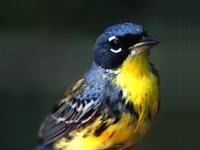 Have you ever wondered why birds go where they go? For example, why does the entire global population of endangered Kirtland's warblers, Dendroica kirtlandii (male pictured, left), fly into central Michigan to nest in jackpine forests? Or why they all fly to the Bahama Islands, where they hang out in scrub during the winter? Determining the areas that are important to birds is Caleb Putnam's job. Putnam, a Grand Rapids Community College instructor, was just hired to begin an internationally recognized bird conservation program in Michigan called "Important Bird Areas" or IBAs. The IBA is the brainchild of Birdlife International, a London-based bird conservation organization that started the program in 1984. It has IBA programs running in North and South America, Africa, Antarctica, Europe, the Pacific islands and the Middle East. Michigan will join 45 other states that have a program up and running.
Have you ever wondered why birds go where they go? For example, why does the entire global population of endangered Kirtland's warblers, Dendroica kirtlandii (male pictured, left), fly into central Michigan to nest in jackpine forests? Or why they all fly to the Bahama Islands, where they hang out in scrub during the winter? Determining the areas that are important to birds is Caleb Putnam's job. Putnam, a Grand Rapids Community College instructor, was just hired to begin an internationally recognized bird conservation program in Michigan called "Important Bird Areas" or IBAs. The IBA is the brainchild of Birdlife International, a London-based bird conservation organization that started the program in 1984. It has IBA programs running in North and South America, Africa, Antarctica, Europe, the Pacific islands and the Middle East. Michigan will join 45 other states that have a program up and running.
Bird Counts
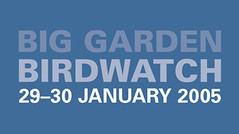 This year's Big Garden Birdwatch in the UK, organized by the Royal Society for the Protection of Birds (BirdLife in the UK), enjoyed record participation. The results show more than 470,000 people, including 86,000 children, watched their gardens and local parks during the weekend of 28-29 January and counted a staggering 8.1 million birds from 80 different species in more than 270,000 gardens. This story discusses some of the surprising results.
This year's Big Garden Birdwatch in the UK, organized by the Royal Society for the Protection of Birds (BirdLife in the UK), enjoyed record participation. The results show more than 470,000 people, including 86,000 children, watched their gardens and local parks during the weekend of 28-29 January and counted a staggering 8.1 million birds from 80 different species in more than 270,000 gardens. This story discusses some of the surprising results.
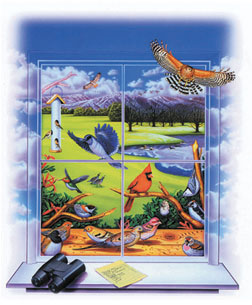 The ninth annual Great Backyard Bird Count, which took place from 17-20 February in the USA set new records as participation soared across the United States and Canada. From backyards to wildlife refuges, bird watchers tallied a record-breaking 623 bird species and 7.5 million individual birds during the four-day event, coordinated by the National Audubon (BirdLife International in the USA) and the Cornell Lab of Ornithology. Participants sent in more than 60,000 checklists, providing a wealth of information unmatched in previous years.
The ninth annual Great Backyard Bird Count, which took place from 17-20 February in the USA set new records as participation soared across the United States and Canada. From backyards to wildlife refuges, bird watchers tallied a record-breaking 623 bird species and 7.5 million individual birds during the four-day event, coordinated by the National Audubon (BirdLife International in the USA) and the Cornell Lab of Ornithology. Participants sent in more than 60,000 checklists, providing a wealth of information unmatched in previous years.
People Hurting Birds
Federal Wildlife inspectors recently discovered hundreds of dead birds in piece of equipment common to the oil drilling industry that officials had not suspected caused migratory bird deaths. For years, wildlife inspectors have worked closely with oil producers to reduce bird deaths in open pits and open tanks, but no one realized heater treaters were a danger to migratory birds until the agency received a complaint from a rural resident of Pratt County, said John Brooks, special agent with the U.S. Fish and Wildlife Service. "I don't think anybody really realized how big a problem this could be -- and certainly the Service was not aware of the bird deaths taking place in heater treaters," Brooks said Wednesday. The equipment is used routinely in oil fields to separate gas, oil and saltwater pumped from the ground. Heater treaters are enclosed cylindrical stacks that are typically about 20 feet tall and 5 feet in diameter with a 6-inch to 8-inch wide exhaust stack.
Birds Hurting People
A flock of crows is terrorizing people living on an estate in Warwick, UK, local residents have said. The birds initially attacked cars by pulling off windscreen wipers and scratching the paint. But now they have moved on to attacking the residents themselves, similar to scenes in the Alfred Hitchcock thriller The Birds. "They have attempted to attack a lady and she was pretty frightened by it," said Linda Pheasey, who lives on Milton Avenue where the crows congregate. "It is most unusual for these birds to do this," said Colin Wilkinson, conservation officer with the RSPB.
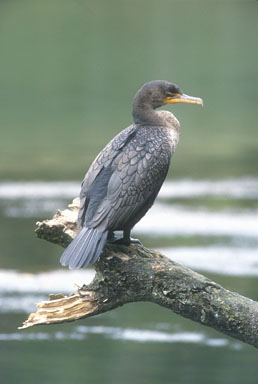 The area around Lake Eola, Florida, has it all -- a sparkling fountain, waterside cafe, swan boat rides and .. a mountain of bird droppings. The foul smelling white film cakes lampposts, covers sidewalks and park benches and stains the bushes and trees around a 100-foot stretch of the lake. Drivers who dare park their cars do so at their own risk. Within minutes, a car can turn from black to spotted along "bird poop alley," as residents call it. The offenders? Cormorants (pictured, left); those diving birds that catch fish, and migrate south annually. These birds are such prolific poopers that their South American cousins helped create Peru's guano islands. To convince the birds to move on, the city tried to remove the trees, but learned that the birds' nests were protected under federal law, said Orlando Rolon, a spokesman for Mayor Buddy Dyer. The situation was tolerable until city workers removed cypress trees off a small island in the middle of the lake. GrrlScientist notes; this story just goes to show that, like most bird-human conflicts, this is really a problem that was created by people.
The area around Lake Eola, Florida, has it all -- a sparkling fountain, waterside cafe, swan boat rides and .. a mountain of bird droppings. The foul smelling white film cakes lampposts, covers sidewalks and park benches and stains the bushes and trees around a 100-foot stretch of the lake. Drivers who dare park their cars do so at their own risk. Within minutes, a car can turn from black to spotted along "bird poop alley," as residents call it. The offenders? Cormorants (pictured, left); those diving birds that catch fish, and migrate south annually. These birds are such prolific poopers that their South American cousins helped create Peru's guano islands. To convince the birds to move on, the city tried to remove the trees, but learned that the birds' nests were protected under federal law, said Orlando Rolon, a spokesman for Mayor Buddy Dyer. The situation was tolerable until city workers removed cypress trees off a small island in the middle of the lake. GrrlScientist notes; this story just goes to show that, like most bird-human conflicts, this is really a problem that was created by people.
Avian Influenza News
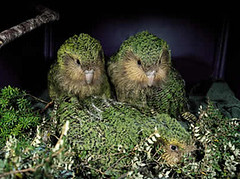 New Zealand's iconic flightless birds, the kiwi and the near-extinct kakapo, will be vaccinated against bird flu if the virus is detected anywhere near this isolated South Pacific nation, a conservationist said Friday. New Zealand remains free of the deadly H5N1 bird flu strain, but native birds are likely highly susceptible to it, said Paul Jansen, leader of the Department of Conservation's kiwi and kakapo recovery team. All 86 surviving kakapo, Strigops habroptilus (pictured), the world's largest flightless parrot, hundreds of captive kiwi species and others in the wild that have been fitted with locator transmitters and will be vaccinated if the virus nears New Zealand, particularly if there are any infections detected in neighboring Australia, Jansen said. New Zealand's 75,000 remaining kiwi likely would suffer a high rate of mortality if H5N1 bird flu reaches New Zealand, he said, adding that the flightless species are more vulnerable to disease because they have never been exposed to foreign diseases.
New Zealand's iconic flightless birds, the kiwi and the near-extinct kakapo, will be vaccinated against bird flu if the virus is detected anywhere near this isolated South Pacific nation, a conservationist said Friday. New Zealand remains free of the deadly H5N1 bird flu strain, but native birds are likely highly susceptible to it, said Paul Jansen, leader of the Department of Conservation's kiwi and kakapo recovery team. All 86 surviving kakapo, Strigops habroptilus (pictured), the world's largest flightless parrot, hundreds of captive kiwi species and others in the wild that have been fitted with locator transmitters and will be vaccinated if the virus nears New Zealand, particularly if there are any infections detected in neighboring Australia, Jansen said. New Zealand's 75,000 remaining kiwi likely would suffer a high rate of mortality if H5N1 bird flu reaches New Zealand, he said, adding that the flightless species are more vulnerable to disease because they have never been exposed to foreign diseases.
A bird flu vaccine being stockpiled by the US government in preparation for a possible pandemic is only modestly effective, protecting approximately half the people who receive it, scientists report. In addition, it must be given in such high doses that if a pandemic were to start soon, manufacturers could not begin to make enough vaccine for all who would need it.
Bird Publications and Stamps
The March 2006 Issue of the All-Bird Bulletin is now available as a free download [PDF]. The All-Bird Bulletin is a news and information-sharing publication for participants of the North American Bird Conservation Initiative (NABCI). NABCI is a coalition of organizations and initiatives dedicated to advancing integrated bird conservation in North America. Previous issues are also indexed on the site as free downloads.
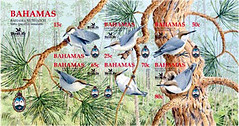 A new set of stamps highlights one of the Bahamas rarest birds, Bahama Nuthatch, Sitta insularis (pictured). Although previously regarded as a variety of Brown-headed Nuthatch, S. pusilla, recent research suggests that the birds found on Grand Bahama could be a distinct species. Whatever the taxonomic consensus turns out to be, it is clear that the nuthatch is under threat. Its population is estimated to be approximately 1800 individuals, and they are found only in Caribbean Pine, Pinus caribaea, which is one of the most critically threatened habitats in the West Indies.
A new set of stamps highlights one of the Bahamas rarest birds, Bahama Nuthatch, Sitta insularis (pictured). Although previously regarded as a variety of Brown-headed Nuthatch, S. pusilla, recent research suggests that the birds found on Grand Bahama could be a distinct species. Whatever the taxonomic consensus turns out to be, it is clear that the nuthatch is under threat. Its population is estimated to be approximately 1800 individuals, and they are found only in Caribbean Pine, Pinus caribaea, which is one of the most critically threatened habitats in the West Indies.
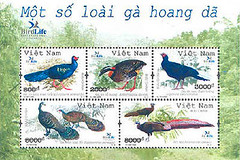 In consultation with ornithological experts from the BirdLife International Vietnam Program, the Ministry of Post and Telecommunication of Vietnam will depict five Galliformes species on a new stamp set (pictured). Galliformes are fowls; chickens and their relatives. All five species pictured on these stamps have small populations that are declining because of habitat loss and fragmentation and high levels of hunting. BirdLife International considers three species as Endangered, while the others are listed as Near Threatened. "The stamps will remind people of Vietnam's rich and spectacular bird life, which is the envy of the rest of the world. It's our duty to protect these magnificent species and their forest homes - they're a valuable part of our natural heritage," said Pham Tuan Anh, BirdLife Vietnam Program Manager.
In consultation with ornithological experts from the BirdLife International Vietnam Program, the Ministry of Post and Telecommunication of Vietnam will depict five Galliformes species on a new stamp set (pictured). Galliformes are fowls; chickens and their relatives. All five species pictured on these stamps have small populations that are declining because of habitat loss and fragmentation and high levels of hunting. BirdLife International considers three species as Endangered, while the others are listed as Near Threatened. "The stamps will remind people of Vietnam's rich and spectacular bird life, which is the envy of the rest of the world. It's our duty to protect these magnificent species and their forest homes - they're a valuable part of our natural heritage," said Pham Tuan Anh, BirdLife Vietnam Program Manager.
California Condor News
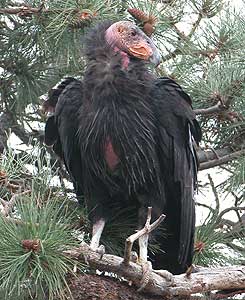 For the first time in more than 100 years, California condors, Gymnogyps californianus (pictured), are nesting in the northern part of the state, scientists said. The condor couple was discovered Monday, displaying typical nesting behavior inside a hollowed-out redwood tree in Big Sur, a mountainous coastal region south of Monterey, the Ventana Wildlife Society said Tuesday. "For the past 10 years when this sort of thing came up, it turned out to be just in my dreams," Kelly Sorenson, the group's executive director. "Although the view into the cavity is very limited and we can't actually see the egg, we strongly suspect they have an egg based on their behavior at the nest site," said Joe Burnett, a wildlife biologist.
For the first time in more than 100 years, California condors, Gymnogyps californianus (pictured), are nesting in the northern part of the state, scientists said. The condor couple was discovered Monday, displaying typical nesting behavior inside a hollowed-out redwood tree in Big Sur, a mountainous coastal region south of Monterey, the Ventana Wildlife Society said Tuesday. "For the past 10 years when this sort of thing came up, it turned out to be just in my dreams," Kelly Sorenson, the group's executive director. "Although the view into the cavity is very limited and we can't actually see the egg, we strongly suspect they have an egg based on their behavior at the nest site," said Joe Burnett, a wildlife biologist.
Resident Alien Birds
The Canada goose, Branta Canadensis (pictured, top), was first introduced to New Zealand in 1876 and is expanding its range, particularly in eastern areas of both North and South islands. The goose competes with livestock for crops and pasture; fouls farm paddocks, city parks and sports fields; and increases the risk of bird strike around airports. It can carry diseases including avian influenza, Campylobacter, Salmonella and E. coli that may infect people and animals, including rare native birds. NZ Landcare Research scientists, Eric Spurr and Jim Coleman, reviewed goose population trends, damage and control in New Zealand. They say that while goose damage is multifaceted, surprisingly little research has been done on the true economic impacts and how to manage goose numbers more effectively than at present.
Streaming Birds
 This coming week on BirdNote, you will learn more about; how birds produce song; the ring-necked pheasant, Phasianus colchicus; learn more about those wintering birds that will leave your backyards soon; an introduction to the house sparrow, Passer domesticus (which I prefer to call the English sparrow); and Rachael Carson's Silent Spring. BirdNotes transport the listener out of the daily grind with two-minute vignettes that incorporate the rich sounds of birds provided by Cornell University and by other sound recordists, with photographs and written stories that illustrate the interesting -- and in some cases, truly amazing -- abilities of birds. Some of the shows are Pacific Northwest-oriented, but many are of general interest. BirdNote can be heard live, Monday through Friday, 8:58-9:00AM in Western Washington state and Southern British Columbia, Canada, on KPLU radio and now also in North Central Washington state on KOHO radio. All episodes are available in the BirdNote archives, both in written transcript and mp3 formats, along with photographs. Listener ideas and comments are welcomed. [rss mp3/podcast].
This coming week on BirdNote, you will learn more about; how birds produce song; the ring-necked pheasant, Phasianus colchicus; learn more about those wintering birds that will leave your backyards soon; an introduction to the house sparrow, Passer domesticus (which I prefer to call the English sparrow); and Rachael Carson's Silent Spring. BirdNotes transport the listener out of the daily grind with two-minute vignettes that incorporate the rich sounds of birds provided by Cornell University and by other sound recordists, with photographs and written stories that illustrate the interesting -- and in some cases, truly amazing -- abilities of birds. Some of the shows are Pacific Northwest-oriented, but many are of general interest. BirdNote can be heard live, Monday through Friday, 8:58-9:00AM in Western Washington state and Southern British Columbia, Canada, on KPLU radio and now also in North Central Washington state on KOHO radio. All episodes are available in the BirdNote archives, both in written transcript and mp3 formats, along with photographs. Listener ideas and comments are welcomed. [rss mp3/podcast].
Miscellaneous Birds
 Lorelei Delaney might need to start testing her hens for steroids or checking their feed to make sure they aren't pecking at some strange chicken growth hormone because one of them laid a huge egg (pictured) recently. Delaney said she isn't quite sure which hen can claim bragging rights, as they all were still up and pecking. But girls talk, so the hens know exactly which one can lay claim to a monstrous egg that to humans might equate to delivering a toddler. Clint Hickman, co-owner of Hickman's Eggs, has seen a few eggs in his day. Hickman said he often had see larger-than-normal eggs while he was growing up. But this egg, he said, might take the cake. "You'd look for the chicken that was panting or smoking a cigarette," Hickman said. "Sometimes it's just a freak of nature. It could possibly be a triple yolk."
Lorelei Delaney might need to start testing her hens for steroids or checking their feed to make sure they aren't pecking at some strange chicken growth hormone because one of them laid a huge egg (pictured) recently. Delaney said she isn't quite sure which hen can claim bragging rights, as they all were still up and pecking. But girls talk, so the hens know exactly which one can lay claim to a monstrous egg that to humans might equate to delivering a toddler. Clint Hickman, co-owner of Hickman's Eggs, has seen a few eggs in his day. Hickman said he often had see larger-than-normal eggs while he was growing up. But this egg, he said, might take the cake. "You'd look for the chicken that was panting or smoking a cigarette," Hickman said. "Sometimes it's just a freak of nature. It could possibly be a triple yolk."
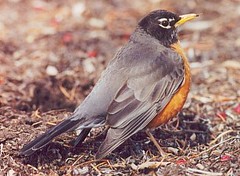 An American robin, Turdus migratorius (pictured, left), apparently carried by strong winds across the North Atlantic Ocean from eastern Canada, now resides in a backyard in the southeast London neighborhood of Peckham, UK. Well-known in North America as a harbinger of spring, the robin is one of only 23 ever recorded in Britain, the Royal Society for the Protection of Birds (RSPB) said Tuesday.
An American robin, Turdus migratorius (pictured, left), apparently carried by strong winds across the North Atlantic Ocean from eastern Canada, now resides in a backyard in the southeast London neighborhood of Peckham, UK. Well-known in North America as a harbinger of spring, the robin is one of only 23 ever recorded in Britain, the Royal Society for the Protection of Birds (RSPB) said Tuesday.
Even though this linked story is not, strictly speaking, about birds, it contains a lovely photoessay that you will like. Signs of spring have been prevalent in the Carolina Piedmont since late January, but now that the vernal equinox has come the scientists there began documenting some of the splendor. The current installment of This Week at Hilton Pond is devoted to some different views of local spring flora, both native and exotic. As always, a list of birds banded during the period is included and this week, they describe a cluster of interesting recaptures, and their miscellaneous nature notes include something perplexing about white-throated sparrows, Zonotrichia albicollis.
For those of you who wonder how Google manages to find the correct results for every query as quickly as it does, you'll be interested to know that it's all due to the birds. Yes, at the heart of Google's search technology is the highly coveted technology, PigeonRank. PigeonRank is a system for ranking web pages that was developed by Google founders, Larry Page and Sergey Brin, at Stanford University. This link provides a unique insider's view of this exciting new technology that further illustrates the importance of birds to humans as we go about our everyday lives.
Surely one of the most startling new findings made during the spread of H5N1 avian influenza has been the discovery of the Tooth Fairy Bird, which is the first avian species discovered by virologists. This account presents a formal description of this newly described taxon along with its natural history and several suggested Latin names.
The Fine Print: Thanks to my bird pals; Scott, Ian, Jeremy, Sara, Dawn, Caren, Bill, Mike, Todd, Ellen and Ron for some of the news story links that you are enjoying here. Thanks to Ian for catching my typos. All photographs that appear here are either linked from the news stories that they accompany or they are linked to the site where they are found. You can follow these links by clicking on individual images.
Previous : : Birds in the News : : Next
tags: Birds in the News, ornithology, birds, avian, newsletter


Condors nesting in Big Sur! That's really great news. I love that photo of the kakapo. They look part bird, part plant. Beautiful.
It's interesting how this Rhinoceros Auklet die-off is being reported from the "south coast of Oregon". It was actually first reported by David Bailey and me between the Columbia River and Tillamook Head (decidedly the north coast). We found birds distributed along the beach in numbers ranging from 8 to 25 birds per kilometer. The work being done by Bob Loeffel which stretches back to 1978 was done at Newport which is on the Central Oregon Coast produced similar results. Ellen Jenkins reported 15 Rhinos along her kilometer of beach on the Longbeach pennisula in SW Washington on March 28. Neither David nor I have found any fresh rhinos since Mar 20.
This means Rhinoceros Auklets wrecked along more than 300 miles of coast line. It occurred days after a strong cold front brought freezing levels to sea level (snow on the beach) and coincided with the northbound movement of rhinos (at least the books say rhinos start heading north in early March). And the majority of individuals in the die-off went in the space of about 1 week immediately after a weird weather event.
On the advice of Peter Pyle, I measured birds long Sunset Beach about 15km south of the Columbia River mouth. 80% of the birds measured appear to have been sub adults. Banded birds recovered along the south coast were both from Alaska and banded last summer (2005).
There is no doubt that something odd is going on in the Pacific Ocean. Most of the wrecked birds which included unusual numbers of Horned Puffins and Fork-tailed Storm-petrels were emaciated suggesting lack of food. I do not believe it's going to be disease related. It's ocean condition related, aggrivated by unusual (la niña?) weather and over a much larger stretch of the coast than is being reported.
Mike Patterson
Astoria OR
Thought you would like the Google reference 3/4 down the page.
thanks everyone for reading these things. they are a lot of work. in fact, at this time, after keeping my commitment to write Birds in the News for more than one year, i am beginning to wonder if it is worth the effort. i have few readers who come here specifically for this "feature", far fewer than i should get considering the numbers who show up for other things that i write that take fafr less effort.
anyway, i'd be interested to hear your input regarding what i am doing wrong with this thing, and what i can do to fix it.
About people commenting less, it's one thing is to post the results of one of you siliness thingies, this stuff is more like "wow, thanks!". Please keep this section. I always search this on fridays. Where else would I learn about pigeonrank?
For a recent update on the continuing saga of the breeding prospects for New Zealand's endangered kakapo, see the NZ Department of Conservation's website --
http://www.doc.govt.nz/templates/news.aspx?id=45354
Archived information can be found on the Royal Forest and Bird Protection Society's website
www.forestandbird.org.nz